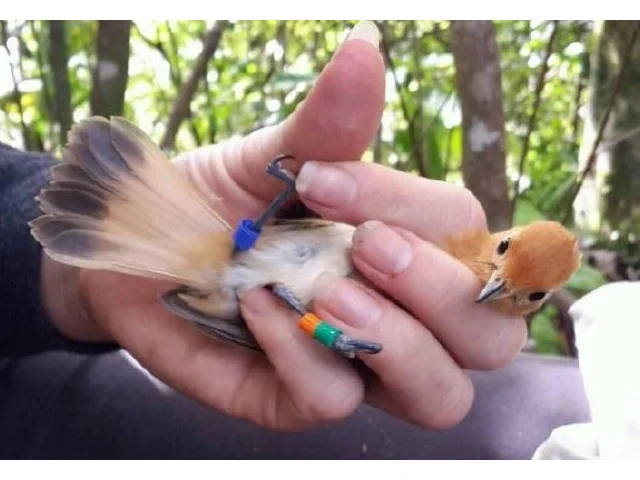New Zealand conservationists work to save Rarotonga Flycatcher
0c83f248-a63b-4ccf-a769-1b152d01d226

In August, the conservation of Rarotonga Flycatcher – locally known as Kakerori – got a boost through hands-on training of local staff from visiting predator-control specialists from New Zealand.
Te Ipukarea Society project officers Liam and Alanna got up close and personal with the rare birds in the Takitumu Conservation Area (TCA), where they joined staff of New Zealand Department of Conservation (DoC) as they traversed rat-baiting tracks, which are crucially important in keeping rat populations low enough to ensure Kakerori’s survival. The two young officers learnt valuable techniques from the New Zealanders, including the setting up of mist nets and learning how to catch, measure, weigh and ring the birds, before releasing them back into the forest.
Kakerori is the main character in an inspiring Cook Islands conservation story. It was formerly common around Rarotonga, yet by the 1900s it was assumed to be extinct. However, in the 1970s and 1980s, surveys found that Kakerori persisted in small numbers on the southern side of Rarotonga.
In the spring of 1987, Rod Hay and Hugh Robertson from New Zealand and Cook Islands biodiversity expert Gerald McCormack launched the Kakerori Recovery Programme, under the auspices of the Cook Islands Conservation Service, with volunteers. The first two breeding seasons established that a total population of 38 Kakerori were restricted to an area of about 150 ha in the headwaters of adjacent valleys, and that their eggs and nestlings were being destroyed by rats, the most common being Black or Ship Rat. That population decline was very much accelerating.
New Zealander Ed Saul became the backbone of the programme during the third season in 1989, poisoning rats, protecting nests and documenting the efforts. As a result of his continued presence, initially as a volunteer and later as a member of the Cook Islands Conservation Service, the number of Kakerori rose from a low of 29 in his first year to more than 132 at the start of the 1996 breeding season. Today it is estimated there are over 400 Kakerori on Rarotonga.
There is also a population of over 100 on Atiu, where a group of 30 birds had been translocated between 2001 and 2003, as Atiu is free of rats. This was done in order to further protect the species, in case something ever happened to the population on Rarotonga. Atiuan bird expert ‘Birdman George’ has been instrumental in the protection of these new inhabitants since their arrival on the island.
Passing on the expertise to a new generation of conservation leaders is essential to continue the progress made in saving the threatened birds and nature of the Pacific, and building on a project that owes so much to the dedication of individuals like Ed Saul.
Te Ipukarea Society project officers Liam and Alanna got up close and personal with the rare birds in the Takitumu Conservation Area (TCA), where they joined staff of New Zealand Department of Conservation (DoC) as they traversed rat-baiting tracks, which are crucially important in keeping rat populations low enough to ensure Kakerori’s survival. The two young officers learnt valuable techniques from the New Zealanders, including the setting up of mist nets and learning how to catch, measure, weigh and ring the birds, before releasing them back into the forest.
Kakerori is the main character in an inspiring Cook Islands conservation story. It was formerly common around Rarotonga, yet by the 1900s it was assumed to be extinct. However, in the 1970s and 1980s, surveys found that Kakerori persisted in small numbers on the southern side of Rarotonga.
In the spring of 1987, Rod Hay and Hugh Robertson from New Zealand and Cook Islands biodiversity expert Gerald McCormack launched the Kakerori Recovery Programme, under the auspices of the Cook Islands Conservation Service, with volunteers. The first two breeding seasons established that a total population of 38 Kakerori were restricted to an area of about 150 ha in the headwaters of adjacent valleys, and that their eggs and nestlings were being destroyed by rats, the most common being Black or Ship Rat. That population decline was very much accelerating.
New Zealander Ed Saul became the backbone of the programme during the third season in 1989, poisoning rats, protecting nests and documenting the efforts. As a result of his continued presence, initially as a volunteer and later as a member of the Cook Islands Conservation Service, the number of Kakerori rose from a low of 29 in his first year to more than 132 at the start of the 1996 breeding season. Today it is estimated there are over 400 Kakerori on Rarotonga.
There is also a population of over 100 on Atiu, where a group of 30 birds had been translocated between 2001 and 2003, as Atiu is free of rats. This was done in order to further protect the species, in case something ever happened to the population on Rarotonga. Atiuan bird expert ‘Birdman George’ has been instrumental in the protection of these new inhabitants since their arrival on the island.
Passing on the expertise to a new generation of conservation leaders is essential to continue the progress made in saving the threatened birds and nature of the Pacific, and building on a project that owes so much to the dedication of individuals like Ed Saul.

